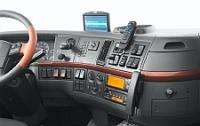Download, install and drive -- the future of automotive software

(PhysOrg.com) -- Computers, mobile phones and other electronic devices regularly download software updates to keep obsolescence at bay. That’s not the norm for cars. But that could change thanks to an automotive software architecture developed by European researchers to keep vehicles up to date with the latest technology.
Developed over two and a half years by a consortium of research institutes, software companies, vehicle manufacturers and parts suppliers, the architecture represents a fundamental building block for an intelligent car able to reconfigure and update itself autonomously, as well as communicate with other devices, such as the driver’s mobile phone or PDA.
“The architecture is the basis for a kind of adaptable onboard operating system… but one that’s much more robust than what is on your PC,” says Martin Sanfridson, a researcher at Volvo Technology in Sweden and the coordinator of the EU-funded DySCAS project in which the architecture was developed.
By using middleware solutions - software that allows different systems to interoperate - the DySCAS architecture could allow the car’s onboard navigation system to automatically access addresses on the driver’s PDA to save them from having to be input manually, or it could play music directly from their mobile phone. More importantly, it would make installing new features and components or changing existing ones considerably easier.
“Cars take many years to develop and most are designed to be on the road for perhaps a decade. In that time, technology can change a lot, but currently there is no efficient way to update the software in these vehicles,” explains Sanfridson.
An obvious example of the technological lag is onboard entertainment. Car companies were still putting cassette players in vehicles ten years ago, even though they had been superseded by CDs and they are still putting CD players in cars today as MP3 players overtake the market. In a rapidly changing and increasingly networked environment, in-car entertainment systems will probably need to be frequently updated in the future in order to keep up with new formats.
Your car has been successfully updated
Much as the software on a personal computer connects to the internet to download and install updates, the DySCAS architecture allows automotive software to automatically download patches and improvements whenever the vehicle is in range of an accessible wireless hotspot - in the owner’s garage, for example, or even in a public parking lot. It could then download new maps for the navigation system, update the entertainment system to play new music formats, or even adjust engine timing based on more fuel efficient settings supplied by the manufacturer.
Sanfridson sees the architecture first being used to update non-critical systems, such as navigation aids and communication and entertainment platforms, though once it proves reliable enough, it could be used to automatically update and adjust critical components and settings.
The researchers also explored the possibility of using the architecture to improve fault tolerance, so that if one electronic control unit (ECU) fails another could automatically step in and perform its function. With increasing numbers of electronic components in cars, controlling everything from security alarms and central locking to automatic braking (ABS) and engine timing, having backup systems and effective load balancing is one way of improving reliability. And ensuring reliability, particularly when a failure could affect safety, is perhaps the biggest challenge for any new automotive technology.
For that reason carmakers and parts manufacturers first concentrated on developing a static, standardised architecture to ensure interoperability between different onboard components and systems in the belief that a static system would be more reliable than a flexible one. Known as AUTOSAR, the architecture is a standard infrastructure on which to run automotive software that is installed before the car rolls off the factory floor and generally cannot be modified afterwards.
It is only now starting to make its way into new models of vehicles. The DySCAS system, as a flexible and adaptable architecture, but one that has yet to be proven reliable, will therefore probably not make its way into commercial vehicles for several years.
“We have spent a lot of time discussing how to apply our architecture with AUTOSAR. Initially it will probably be installed separately to update non-critical systems but further down the road it could be integrated into it,” Sanfridson says.
Volvo Technology and Daimler, the other automaker involved in the project, are both planning to continue developing the DySCAS architecture, and may start implementing some elements of the technology into their vehicles. Sanfridson also notes that Volvo Cars, formerly part of the Swedish Volvo Group and now a unit of Ford, has also expressed interest in the technology, while Volvo Group is studying how it could be used in its trucks and heavy vehicles.
Provided by ICT Results





















